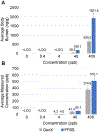Differential Developmental Neurotoxicity and Tissue Uptake of the Per- and Polyfluoroalkyl Substance Alternatives, GenX and PFBS
- PMID: 37943624
- PMCID: PMC11299994
- DOI: 10.1021/acs.est.3c05023
Differential Developmental Neurotoxicity and Tissue Uptake of the Per- and Polyfluoroalkyl Substance Alternatives, GenX and PFBS
Abstract
Per- and polyfluoroalkyl substances (PFAS) are a class of synthetic chemicals with several applications. Multiple adverse health effects are reported for longer carbon chain (≤C8) PFAS. Shorter carbon chain PFAS, [e.g., hexafluoropropylene oxide dimer acid (HFPO-DA; GenX) and perfluorobutanesulfonic acid (PFBS)] were introduced as alternatives. Past studies indicate that longer-chain PFAS are neurotoxic targeting the dopamine pathway, but it is not known if shorter-chain PFAS act similarly. This study aimed to evaluate developmental neurotoxicity and tissue uptake of GenX and PFBS using the zebrafish (Danio rerio). First, acute toxicity was assessed by measuring LC50 at 120 h postfertilization (hpf). Body burden was determined after embryonic exposure (1-72 hpf) to sublethal concentrations of GenX or PFBS by LC-ESI-MS/MS. Locomotor activity using a visual motor response assay at 120 hpf and dopamine levels at 72 hpf was assessed after embryonic exposure. PFBS was more acutely toxic and bioaccumulative than GenX. GenX and PFBS caused hyperactivity at 120 hpf, but stronger behavioral alterations were observed for PFBS. An increase in whole organism dopamine occurred at 40 ppb of GenX, while a decrease was observed at 400 ppb of PFBS. Differences detected in dopamine for these two PFAS indicate differential mechanisms of developmental neurotoxicity.
Keywords: HFPO−DA; behavior; dopamine; perfluoroalkyl substances; perfluorobutanesulfonic acid; polyfluoroalkyl substances; toxicokinetics; zebrafish.
Conflict of interest statement
Notes
The authors declare no competing financial interest.
Figures




Similar articles
-
Metabolomic changes following GenX and PFBS exposure in developing zebrafish.Aquat Toxicol. 2024 Jun;271:106908. doi: 10.1016/j.aquatox.2024.106908. Epub 2024 Apr 3. Aquat Toxicol. 2024. PMID: 38608566 Free PMC article.
-
Comparative toxicokinetics and toxicity of PFOA and its replacement GenX in the early stages of zebrafish.Chemosphere. 2022 Dec;308(Pt 1):136131. doi: 10.1016/j.chemosphere.2022.136131. Epub 2022 Aug 22. Chemosphere. 2022. PMID: 36007738
-
Evaluation of Developmental Toxicity, Developmental Neurotoxicity, and Tissue Dose in Zebrafish Exposed to GenX and Other PFAS.Environ Health Perspect. 2020 Apr;128(4):47005. doi: 10.1289/EHP5843. Epub 2020 Apr 9. Environ Health Perspect. 2020. PMID: 32271623 Free PMC article.
-
Legacy and Emerging Per- and Polyfluoroalkyl Substances: Analytical Techniques, Environmental Fate, and Health Effects.Int J Mol Sci. 2021 Jan 20;22(3):995. doi: 10.3390/ijms22030995. Int J Mol Sci. 2021. PMID: 33498193 Free PMC article. Review.
-
Per- and Polyfluoroalkyl Substances (PFAS): Significance and Considerations within the Regulatory Framework of the USA.Int J Environ Res Public Health. 2021 Oct 23;18(21):11142. doi: 10.3390/ijerph182111142. Int J Environ Res Public Health. 2021. PMID: 34769660 Free PMC article. Review.
Cited by
-
Neurotox Screen? Zebrafish Study Points to PFOS Early-Life Exposure Effects.Environ Health Perspect. 2024 Aug;132(8):84001. doi: 10.1289/EHP15467. Epub 2024 Aug 23. Environ Health Perspect. 2024. PMID: 39177950 Free PMC article.
-
Emergency of per- and polyfluoroalkyl substances in drinking water: Status, regulation, and mitigation strategies in developing countries.Eco Environ Health. 2024 Jun 26;3(3):355-368. doi: 10.1016/j.eehl.2024.05.008. eCollection 2024 Sep. Eco Environ Health. 2024. PMID: 39281067 Free PMC article. Review.
-
Comparative Proteomics Highlights that GenX Exposure Leads to Metabolic Defects and Inflammation in Astrocytes.Environ Sci Technol. 2024 Nov 19;58(46):20525-20539. doi: 10.1021/acs.est.4c05472. Epub 2024 Nov 5. Environ Sci Technol. 2024. PMID: 39499804 Free PMC article.
-
Regrettable Substitutes and the Brain: What Animal Models and Human Studies Tell Us about the Neurodevelopmental Effects of Bisphenol, Per- and Polyfluoroalkyl Substances, and Phthalate Replacements.Int J Mol Sci. 2024 Jun 23;25(13):6887. doi: 10.3390/ijms25136887. Int J Mol Sci. 2024. PMID: 38999997 Free PMC article. Review.
-
Integrated Analysis of Neuroendocrine and Neurotransmission Pathways Following Developmental Atrazine Exposure in Zebrafish.Int J Mol Sci. 2024 Dec 5;25(23):13066. doi: 10.3390/ijms252313066. Int J Mol Sci. 2024. PMID: 39684776 Free PMC article.
References
-
- Giesy JP; Kannan K Global Distribution of Perfluorooctane Sulfonate in Wildlife. Environ. Sci. Technol 2001, 35 (7), 1339–1342. - PubMed
-
- Olsen GW; Burris JM; Ehresman DJ; Froehlich JW; Seacat AM; Butenhoff JL; Zobel LR Half-Life of Serum Elimination of Perfluorooctanesulfonate,Perfluorohexanesulfonate, and Perfluorooctanoate in Retired Fluorochemical Production Workers. Environ. Health Perspect 2007, 115 (9), 1298–1305. - PMC - PubMed
-
- ATSDR. Toxicological Profile for Perfluoroalkyls; Atlanta, GA, 2021. https://www.atsdr.cdc.gov/toxprofiles/tp200.pdf (accessed 2021-08-25).
MeSH terms
Substances
Grants and funding
LinkOut - more resources
Full Text Sources
Miscellaneous

